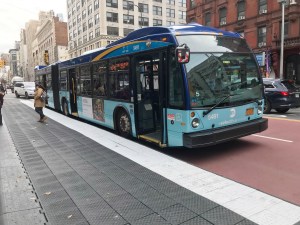SMILE! Bus Lane Cameras Reduce Collisions, Speed Commutes, MTA Says

The MTA’s arsenal of bus-mounted bus lane enforcement cameras has not only sped up buses — but also reduced traffic crashes, a top transit official said on Monday.
Routes with “automated bus lane enforcement,” or ABLE, has 5 percent faster bus speeds and 25 percent fewer crashes over the four years that the bus-mounted camera program has been in operation, MTA New York City Transit President Richard Davey told the City Council transportation committee.
“In no uncertain terms, camera enforcement is one of the most efficient and effective tools at our disposal,” Davey said.
On the 14th Street busway, for example, the M14 had a 24-percent “improvement” in travel times and 14 percent more weekday riders after bus-mounted camera enforcement began, while collisions dropped 42 percent, Davey said.
The MTA has cameras mounted to 450 buses and hopes to grow that number to 1,000 by the end of the year — to cover 80 percent of the city’s bus lanes, Davey said. Gov. Hochul has proposed legislation to expand the cameras’ jurisdiction to also ticket drivers double-parked in front of buses or parked in bus stops and bike lanes.
Bus-mounted cameras have issued 243,000 summonses since their introduction in October 2019. Drivers pay $50 for the first offense and an additional $50 for every additional offense, with a maximum penalty of $250.

Eighty percent of bus lane camera violators only get one summons, while another 12 percent get no more than two write-ups, Davey said.
“The average New Yorker, you know, [with a] personal vehicle, gets a ticket and says, ‘I’m not doing that again,’ which is exactly what we want. We want that behavior change,” Davey said.
“The program will hopefully put itself out of business over time as drivers understand there’s real enforcement going on.”
Big delivery firms like Amazon and UPS, who receive a controversial discount on parking tickets as part of an agreement with the city, are the worst offenders, the Transit honcho added.
‘Targeted Improvements’ for the Worst Routes
NYCT officials also detailed a separate effort to improve bus service earlier Monday during an MTA board presentation in which they presented a new effort to bring “targeted improvements” to 29 of the worst-performing routes.
The struggling lines hail from all five boroughs and make up less than 10 percent of routes — but carry about 20 percent of the city’s bus riders, officials said. All 29 suffer from long journey times, poor reliability, and low rider satisfaction. As part of the effort, the MTA plans to identify and address the specific causes of delays on the routes.
“Focusing on just these 29 routes will benefit not only the 20 percent of our customers who ride them, but thousands of other daily customers who ride other routes that travel through the same corridors,” the MTA’s chief officer for business strategies, Zafira Lateef, told board members.
Lateef reiterated the MTA’s call on the city Department of Transportation to install more dedicated bus lanes, but said the authority would do its part by sending dispatches to congestion areas and working with NYPD to enforce against drivers who block service.
Transit and law enforcement agencies have doled out some 2,000 tickets at problem areas identified on the poor-performing routes in less than two months since the initiative began, according to MTA officials.
In one example transit leaders cited Monday, on the Q66, the MTA worked with the city to clear street vendors on Main Street in Flushing that officials said require pedestrians to walk in the street and in the way of bus service. DOT also plans to install 4.6 miles of bus lanes on Northern Boulevard, which covers much of the route, according to MTA bus official Jimmy Coyle, who presented alongside Lateef.
“These routes have been historically low performers, mostly, and they’ve been stubbornly resistant to improvement,” Coyle said.

The effort is complemented by the MTA’s ongoing effort to redesign its bus routes. For the Q66, which runs east-west between Flushing and Long Island City, MTA officials have proposed to extend the route to Borden Avenue in Hunters Point, getting rid of a congested layover at its current terminus by Queens Plaza beneath the Queensboro Bridge.
On the M101 in Manhattan, the MTA reallocated dispatchers with the goal to reduce “bunching,” or buses running too close to one another, and is also working with the city to install bus lanes on nearly 40 blocks of Third Avenue uptown.
More dedicated lanes are crucial to speeding up buses, one MTA board member noted.
“A couple of the buses that were on the list were the M7 and the M11. They use Columbus and Amsterdam Avenues on the Upper West Side which are consistently choked with traffic,” said Andrew Albert.
“We really need dedicated bus lanes on those avenues if we’re going to see a difference there.”
City DOT has fallen behind on installing its legally-required mileage of bus lanes every year under the city’s Streets Plan, implementing less than a quarter of the 20 miles required under the legislation in 2022, amid agency staffing shortages and high-level Adams administration officials intervening to scuttle certain projects.
MTA CEO and Chairman Janno Lieber previously urged Mayor Adams to meet his legal minimums. The MTA remains optimistic that the city can hold up its end of the arrangement, one senior official said Monday.
“We’re kind of doing everything we can to assist DOT to try to get them to get more miles,” said MTA chief of operations planning Judy McClain. “They had a lot of projects that were kind of ready to go at the end of the year, so we’re hoping this spring they can really jump in and get some key projects done in this year.”
Starting October 7th, we’re speeding up your ride. pic.twitter.com/VnH66s57Mp
— NYCT Bus (@NYCTBus) September 23, 2019
Additional reporting by David Meyer




